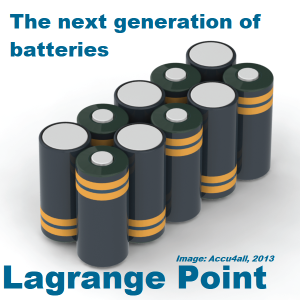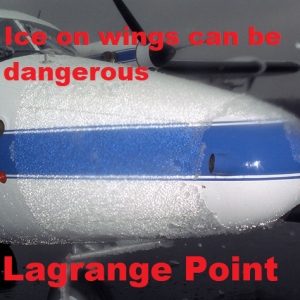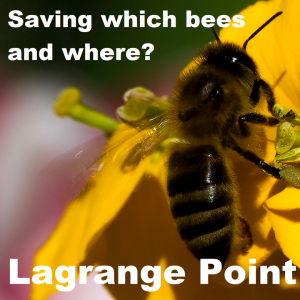Episodes

Monday Jan 25, 2021
Episode 415 - Greener ways to make Hydrogen and Ammonia
Monday Jan 25, 2021
Monday Jan 25, 2021
You've probably heard about the wonders of a Hydrogen economy, but how can we make it better for the environment. Synthesizing Ammonia helped feed the planet, but at a huge environmental cost. How can we produce Ammonia without harming the environment? Production of ammonia (and fertilizer) has a huge carbon footprint. How can we clean it up? Hydrogen fuel cells could help decarbonize our economy, but how do we produce it cleanly? Electrolysis can separate hydrogen from water, but how can we do it more efficiently?

Monday Jan 04, 2021
Episode 412 - Magnetic Glues and Chemical gears
Monday Jan 04, 2021
Monday Jan 04, 2021
Waiting for glue to cure can take a long time, but can magnets speed it up? We use epoxy to glue together so much of the modern world, but it takes a lot of energy to cure it. Is there a way to make epoxy glues more 'energy efficient' with magnets? Magnetically activate glues can literally stick your shoes together. Gears are one of the most fundamental mechanical elements, can we get chemicals to form gears themselves. A 1mm thick sheet with some chemicals and you can get gears to form themselves. Small gear trains and mechanical motion can power soft and flexible machines.
References:
- Richa Chaudhary, Varun Chaudhary, Raju V. Ramanujan, Terry W.J. Steele. Magnetocuring of temperature failsafe epoxy adhesives. Applied Materials Today, 2020; 21: 100824 DOI: 10.1016/j.apmt.2020.100824
- Abhrajit Laskar, Oleg E. Shklyaev, Anna C. Balazs. Self-Morphing, Chemically Driven Gears and Machines. Matter, 2020 DOI: 10.1016/j.matt.2020.11.014

Monday Nov 09, 2020
Episode 404 - Ants , Acid, and Yeast that grow acid
Monday Nov 09, 2020
Monday Nov 09, 2020
Ants, acid and yeast that can grow their own acid. Ants use formic acid to keep their colony safe inside and out. By ingesting formic acid, Ants are able to ward off dangerous pathogens. Passing food with your mouth isn't very socially distant, but ants eat acid to make it safe. How can yeast be used to 'grow' materials needed to make perfume and dyes? Succinic acid is a useful chemical precursor, but its possible to grow yeast that are able yo produce on scale as a by product. Finding just the right genes with CRISPR and super computers can turn yeast into a chemical production powerhouse.
- Simon Tragust, Claudia Herrmann, Jane Häfner, Ronja Braasch, Christina Tilgen, Maria Hoock, Margarita Artemis Milidakis, Roy Gross, Heike Feldhaar. Formicine ants swallow their highly acidic poison for gut microbial selection and control. eLife, 2020; 9 DOI: 10.7554/eLife.60287
- Patrick F. Suthers, Hoang V. Dinh, Zia Fatma, Yihui Shen, Siu Hung Joshua Chan, Joshua D. Rabinowitz, Huimin Zhao, Costas D. Maranas. Genome-scale metabolic reconstruction of the non-model yeast Issatchenkia orientalis SD108 and its application to organic acids production. Metabolic Engineering Communications, 2020; 11: e00148 DOI: 10.1016/j.mec.2020.e00148

Monday Nov 02, 2020
Episode 403 - Taking pollutants out of our water, factories and environment
Monday Nov 02, 2020
Monday Nov 02, 2020
How can we take pollutants easily out of our water, factories and environment? PFAS contamination is difficult to clear up, but a new method could attract, trap and destroy it with electrodes. PFAS can be found in many things, but taking it out of an area has often been very difficult. Using a tunenable electrode, in 3 hours you could extract and destroy PFAS in contaminated water. A combined clay and glass filter could neatly trap and extract CO2 from a gassy mixture. industrial processes often produce CO2 amongst other gases, but how can you quickly only separate out that CO2, reuse it and prevent it from being emitted? Lead in drinking water is a serious issue,but understanding the amount of exposure is difficult. A new method for analysing lead in drinking water tips acid onto 'filled' filters.
- Kwiyong Kim, Paola Baldaguez Medina, Johannes Elbert, Emmanuel Kayiwa, Roland D. Cusick, Yujie Men, Xiao Su. Molecular Tuning of Redox‐Copolymers for Selective Electrochemical Remediation. Advanced Functional Materials, 2020; 2004635 DOI: 10.1002/adfm.202004635
- Basic Information on PFAS. (2018, December 06). Retrieved October 31, 2020, from https://www.epa.gov/pfas/basic-information-pfas
- Martin Rieß, Renée Siegel, Jürgen Senker, Josef Breu. Diammonium-Pillared MOPS with Dynamic CO2 Selectivity. Cell Reports Physical Science, 2020; 100210 DOI: 10.1016/j.xcrp.2020.100210
- Weiyi Pan, Elizabeth R. Johnson, Daniel E. Giammar. Accumulation on and extraction of lead from point-of-use filters for evaluating lead exposure from drinking water. Environmental Science: Water Research & Technology, 2020; 6 (10): 2734 DOI: 10.1039/d0ew00496k

Monday Oct 05, 2020
Episode 399 - Avoiding Fatbergs and Breaking down Plastic
Monday Oct 05, 2020
Monday Oct 05, 2020
Breaking up fatbergs, and breaking down plastic with smarter materials. Sewers are a dangerous place, with fat bergs and sulphuric acid, but can they be cleaned up? Portland Cement has helped build the modern world, but does it also cause problems in our sewers? how can we stop our sewers from corroding with better materials? Breaking down plastic takes a long time, but through in a super team of enzymes and it could be done in days. A super team of enzymes helps break down plastic and could lead to a circular economy.
- Brandon C. Knott, Erika Erickson, Mark D. Allen, Japheth E. Gado, Rosie Graham, Fiona L. Kearns, Isabel Pardo, Ece Topuzlu, Jared J. Anderson, Harry P. Austin, Graham Dominick, Christopher W. Johnson, Nicholas A. Rorrer, Caralyn J. Szostkiewicz, Valérie Copié, Christina M. Payne, H. Lee Woodcock, Bryon S. Donohoe, Gregg T. Beckham, John E. McGeehan. Characterization and engineering of a two-enzyme system for plastics depolymerization. Proceedings of the National Academy of Sciences, 2020; 202006753 DOI: 10.1073/pnas.2006753117
- Rajeev Roychand, Jie Li, Saman De Silva, Mohammad Saberian, David Law, Biplob Kumar Pramanik. Development of zero cement composite for the protection of concrete sewage pipes from corrosion and fatbergs. Resources, Conservation and Recycling, 2021; 164: 105166 DOI: 10.1016/j.resconrec.2020.105166

Monday Sep 21, 2020
Episode 397 - Ignobel Prize '20 - Physics
Monday Sep 21, 2020
Monday Sep 21, 2020
We celebrate the Ignobel Prizes once again, and this year we take a deep dive into the Physics prize for 2020. Faraday waves (standing waves in liquids or liquid filled objects) look pretty, but can anything filled with like have one? What about a worm? Can you make Faraday waves and resonant frequencies in Worms? What happens when a laser, a worm, and a speaker go into a lab? The result is an Ignobel Prize.
- Maksymov, I.S., Pototsky, A. Excitation of Faraday-like body waves in vibrated living earthworms. Sci Rep 10, 8564 (2020). https://doi.org/10.1038/s41598-020-65295-4
- 2020 Ceremony. (2020, September 18). Retrieved September 18, 2020, from https://www.improbable.com/ig-about/the-30th-first-annual-ig-nobel-prize-ceremony/

Monday Sep 14, 2020
Episode 396 - Is that food safe to eat
Monday Sep 14, 2020
Monday Sep 14, 2020
Is that food safe to eat? How can you tell if food has gone bad beyond just reading a date? Ever been confused by best before or use by? A new type of label could make it a mater of colors. Color based labels could help detect if your food has gone bad or is contaminated by bacteria. How can we study the microbes that live inside our intestines? The gut microbiome is incredibly fascinating but difficult to study without damaging it. A tiny pill that takes snapshots of micro organisms inside your stomach as it passes through.
- Doyoon Kim, Yunteng Cao, Dhanushkodi Mariappan, Michael S. Bono Jr., A. John Hart, Benedetto Marelli. A Microneedle Technology for Sampling and Sensing Bacteria in the Food Supply Chain. Advanced Functional Materials, 2020 DOI: 10.1002/adfm.202005370
- Lu Chen, Lina Gruzinskyte, Steffen Lynge Jørgensen, Anja Boisen, Sarvesh Kumar Srivastava. An Ingestible Self-Polymerizing System for Targeted Sampling of Gut Microbiota and Biomarkers. ACS Nano, 2020; DOI: 10.1021/acsnano.0c05426

Monday Aug 03, 2020
Episode 390 - Cool fabrics, melting ice and recycling e-waste
Monday Aug 03, 2020
Monday Aug 03, 2020
From cool fabrics, to melting ice and recycling e-waste. How can a fabric let air through, but keep water out? Clothing that is breathable, water resistant and thermally efficient hits the sweet spot of a super fabric. Making clothes more efficient at cooling but also self cleaning can reduce our reliance on air conditioning. Using electricity and some polymers we can spin up some new cool clothing fabrics. Melting ice in your frozen over freezer can be made easier with biphillic materials. Materials that both hate and love water at the same time, can help melt ice and make heater exchangers more efficient. Recycling e-waste can be tricky, but what if we could use the by-products to make new, stronger coatings for steel? Turning e-waste into a steel boosting coating.
- Rumana Hossain, Veena Sahajwalla. Material Microsurgery: Selective Synthesis of Materials via High-Temperature Chemistry for Microrecycling of Electronic Waste. ACS Omega, 2020; 5 (28): 17062 DOI: 10.1021/acsomega.0c00485
- Xi Yu, Yang Li, Xianfeng Wang, Yang Si, Jianyong Yu, Bin Ding. Thermoconductive, Moisture-Permeable, and Superhydrophobic Nanofibrous Membranes with Interpenetrated Boron Nitride Network for Personal Cooling Fabrics. ACS Applied Materials & Interfaces, 2020; 12 (28): 32078 DOI: 10.1021/acsami.0c04486
- Yashraj Gurumukhi, Shreyas Chavan, Soumyadip Sett, Kalyan Boyina, Srivasupradha Ramesh, Peter Sokalski, Kirk Fortelka, Maury Lira, Deokgeun Park, Juo-Yun Chen, Shreyas Hegde, Nenad Miljkovic. Dynamic Defrosting on Superhydrophobic and Biphilic Surfaces. Matter, 2020; DOI: 10.1016/j.matt.2020.06.029

Monday Jul 20, 2020
Episode 388 - Cleaning, drinking and shaping water
Monday Jul 20, 2020
Monday Jul 20, 2020
Making water safe to drink, from evaporation to treatment. How do you simply evaporate water to make it safe? A piece of aluminium and a laser can hold the key to providing cheap and safe drinking water to the world. Pharmaceutical waste can build up in waster water, so how can it be treated? How can two little electrodes deal with the problem of pharmaceutical waste in water? Changing the course of a river can have huge consequences. What can we learn by studying the changes caused by the Panama Canal?
- Subhash C. Singh, Mohamed ElKabbash, Zilong Li, Xiaohan Li, Bhabesh Regmi, Matthew Madsen, Sohail A. Jalil, Zhibing Zhan, Jihua Zhang, Chunlei Guo. Solar-trackable super-wicking black metal panel for photothermal water sanitation. Nature Sustainability, 2020; DOI: 10.1038/s41893-020-0566-x
- Yassine Ouarda, Clément Trellu, Geoffroy Lesage, Matthieu Rivallin, Patrick Drogui, Marc Cretin. Electro-oxidation of secondary effluents from various wastewater plants for the removal of acetaminophen and dissolved organic matter. Science of The Total Environment, 2020; 738: 140352 DOI: 10.1016/j.scitotenv.2020.140352
- Jorge Salgado, María I. Vélez, Catalina González-Arango, Neil L. Rose, Handong Yang, Carme Huguet, Juan S. Camacho, Aaron O'Dea. A century of limnological evolution and interactive threats in the Panama Canal: Long-term assessments from a shallow basin. Science of The Total Environment, 2020; 729: 138444 DOI: 10.1016/j.scitotenv.2020.138444

Monday Jun 29, 2020
Episode 385 - Understanding what makes water stick together
Monday Jun 29, 2020
Monday Jun 29, 2020
What seems simple but it's deceptively complex. What makes water molecules stick together, or ice to float on top? Water has many mysteries, like ice floating on liquid. The key lies in the energy distribution. Shooting super high frequency lasers at water can help figure out what makes ice float or water stick together. Cheap and efficient ways to clean water is essential for saving lives across the globe. How can cyrstaline sponges help soak up bad chemicals like hexavalent chromium.
- Martina Havenith-Newen, Raffael Schwan, Chen Qu, Devendra Mani, Nitish Pal, Gerhard Schwaab, Joel M. Bowman, Gregory Tschumper. Observation of the low frequency spectrum of water trimer as a sensitive test of the water trimer potential and the dipole moment surface. Angewandte Chemie International Edition, 2020; DOI: 10.1002/anie.202003851
- Bardiya Valizadeh, Tu N. Nguyen, Stavroula Kampouri, Daniel T. Sun, Mounir D. Mensi, Kyriakos Stylianou, Berend Smit, Wendy L. Queen. A novel integrated Cr(vi) adsorption–photoreduction system using MOF@polymer composite beads. Journal of Materials Chemistry A, 2020; DOI: 10.1039/d0ta01046d

Monday May 11, 2020
Episode 378 - Maple Syrup Golden tongues and antioxidants
Monday May 11, 2020
Monday May 11, 2020
Taste testing maple syrup and long lasting antioxidants. How do you judge the taste of something as complex as maple syrup? How can a golden tongue help find gold, silver and bronze maple syrups? Antioxidants can keep food fresh and wounds safe, so how can they be made long lasting? Tannic acid often found in wines can make great antioxidants, but how to make their chemical effect long lasting? Fine woven meshes embedded with antioxidants can help flexible wrap food and wounds to keep them safe.
- Simon Forest, Trevor Théorêt, Julien Coutu, Jean-Francois Masson. A high-throughput plasmonic tongue using an aggregation assay and nonspecific interactions: classification of taste profiles in maple syrup. Analytical Methods, 2020; DOI: 10.1039/C9AY01942A
- Adwait Gaikwad, Hanna Hlushko, Parvin Karimineghlani, Victor Selin, Svetlana A. Sukhishvili. Hydrogen-Bonded, Mechanically Strong Nanofibers with Tunable Antioxidant Activity. ACS Applied Materials & Interfaces, 2020; 12 (9): 11026 DOI: 10.1021/acsami.9b23212

Monday Apr 20, 2020
Episode 375 - Solar Panels that work at night and on greenhouses
Monday Apr 20, 2020
Monday Apr 20, 2020
From solar panels on greenhouses to ones that work at night. How can you use radiant heat to make a solar panel work at night? Is there a way to harness energy from the sun even at night? Can you cover a greenhouse with solar panels without destroying your crops? What's the tipping point for harvesting solar energy for your greenhouse? Balancing the light needs of solar panels and of crops in a greenhouse. How does the photosynthesis process know which path to take? Shinning a light on the photosynthetic process.
- Tristan Deppe, Jeremy N. Munday. Nighttime Photovoltaic Cells: Electrical Power Generation by Optically Coupling with Deep Space. ACS Photonics, 2019; 7 (1): 1 DOI: 10.1021/acsphotonics.9b00679
- Eshwar Ravishankar, Ronald E. Booth, Carole Saravitz, Heike Sederoff, Harald W. Ade, Brendan T. O’Connor. Achieving Net Zero Energy Greenhouses by Integrating Semitransparent Organic Solar Cells. Joule, 2020; DOI: 10.1016/j.joule.2019.12.018
- Philip D. Laible, Deborah K. Hanson, James C. Buhrmaster, Gregory A. Tira, Kaitlyn M. Faries, Dewey Holten, Christine Kirmaier. Switching sides—Reengineered primary charge separation in the bacterial photosynthetic reaction center. Proceedings of the National Academy of Sciences, 2020; 117 (2): 865 DOI: 10.1073/pnas.1916119117

Monday Apr 13, 2020
Episode 374 - Lasers, Metal and Insect wings vs Bacteria
Monday Apr 13, 2020
Monday Apr 13, 2020
Taking the fight to bacteria with lasers, metal and insect wings. How can lasers help make a material into a bacteria destroyer? Metal in fantasy has demon slaying properties, but how can it help fight bacteria? What can we learn from insect wings to help make safer implants? What is it about silver that makes it good for killing bacteria (and werewolves). Why are metals so dangerous for bacteria? How can we treat and use metal to make medical devices safer from bacteria?
- Vidhya Selvamani, Amin Zareei, Ahmed Elkashif, Murali Kannan Maruthamuthu, Shirisha Chittiboyina, Davide Delisi, Zheng Li, Lirong Cai, Vilas G. Pol, Mohamed N. Seleem, Rahim Rahimi. Hierarchical Micro/Mesoporous Copper Structure with Enhanced Antimicrobial Property via Laser Surface Texturing. Advanced Materials Interfaces, 2020; 1901890 DOI: 10.1002/admi.201901890
- Asmaa A. Sadoon, Prabhat Khadka, Jack Freeland, Ravi Kumar Gundampati, Ryan H. Manso, Mason Ruiz, Venkata R. Krishnamurthi, Suresh Kumar Thallapuranam, Jingyi Chen, Yong Wang. Silver Ions Caused Faster Diffusive Dynamics of Histone-Like Nucleoid-Structuring Proteins in Live Bacteria. Applied and Environmental Microbiology, 2020; 86 (6) DOI: 10.1128/AEM.02479-19
- J. Jenkins, J. Mantell, C. Neal, A. Gholinia, P. Verkade, A. H. Nobbs, B. Su. Antibacterial effects of nanopillar surfaces are mediated by cell impedance, penetration and induction of oxidative stress. Nature Communications, 2020; 11 (1) DOI: 10.1038/s41467-020-15471-x

Monday Mar 30, 2020
Episode 372 - Flexible and wearable electronics
Monday Mar 30, 2020
Monday Mar 30, 2020
How can we make flexible electronics for our clothing? What does it take to make a screen that's flexible without relying on plastics? What aquatic by product can help make biodegradable, flexible electronics? Why do your towels go hard when you dry them in the sun? What happens on cotton fibres to make them stiffen up in the sun? How does fabric softener work - we're really not sure.
- Nara Kim, Samuel Lienemann, Ioannis Petsagkourakis, Desalegn Alemu Mengistie, Seyoung Kee, Thomas Ederth, Viktor Gueskine, Philippe Leclère, Roberto Lazzaroni, Xavier Crispin, Klas Tybrandt. Elastic conducting polymer composites in thermoelectric modules. Nature Communications, 2020; 11 (1) DOI: 10.1038/s41467-020-15135-w
- Xiaopan Zhang, Tengyang Ye, Xianghao Meng, Zhihui Tian, Lihua Pang, Yaojie Han, Hai Li, Gang Lu, Fei Xiu, Hai-Dong Yu, Juqing Liu, Wei Huang. Sustainable and Transparent Fish Gelatin Films for Flexible Electroluminescent Devices. ACS Nano, 2020; DOI: 10.1021/acsnano.9b09880
- Takako Igarashi, Masato Hoshi, Koichi Nakamura, Takeshi Kaharu, Ken-ichiro Murata. Direct Observation of Bound Water on Cotton Surfaces by Atomic Force Microscopy and Atomic Force Microscopy–Infrared Spectroscopy. The Journal of Physical Chemistry C, 2020; 124 (7): 4196 DOI: 10.1021/acs.jpcc.0c00423

Monday Feb 24, 2020
Episode 367 - Sustainable and green Chemistry
Monday Feb 24, 2020
Monday Feb 24, 2020
Making chemistry green and sustainable, from cheaper catalyst to sorting solvents. How can you make catalysts cheaper and re-usable? Is there a cheaper catalyst to breakdown CO2? How can we make a circular carbon economy? Solvents play an important role in chemistry so how do you greenly find the right match? Green chemistry can be made more efficient using CO2.
- Youngdong Song, Ercan Ozdemir, Sreerangappa Ramesh, Aldiar Adishev, Saravanan Subramanian, Aadesh Harale, Mohammed Albuali, Bandar Abdullah Fadhel, Aqil Jamal, Dohyun Moon, Sun Hee Choi, Cafer T. Yavuz. Dry reforming of methane by stable Ni–Mo nanocatalysts on single-crystalline MgO. Science, 2020; 367 (6479): 777 DOI: 10.1126/science.aav2412
- Suyong Han, Keshav Raghuvanshi, Milad Abolhasani. Accelerated Material-Efficient Investigation of Switchable Hydrophilicity Solvents for Energy-Efficient Solvent Recovery. ACS Sustainable Chemistry & Engineering, 2020; DOI: 10.1021/acssuschemeng.9b07304

Monday Oct 28, 2019
Episode 350 - Developing, tracking, recycling new materials
Monday Oct 28, 2019
Monday Oct 28, 2019
Smart phones, computers, televisions and even children's toys are part of what makes our modern world so exciting. But these often rely on plastics and rare earth metals which are hard to recycle. Are there efficient ways to capture all those rare earth metals? How are rare earth metals in old phones recycled today, and can we make it better? Knowing which bin to put plastic in is difficult, so what if there was a more universal way to recycle plastics? How does turning plastic into a gas with the help of steam help create a circular plastic economy? How can some steam power help crack plastics back into their most basic forms? Is it possible to recycle plastics without to build whole new plastic refineries? Regulation is often playing catch up to making materials safe. Are the latest generation of 'safe' fire retardants any safer than those that came before?
References:
Robert F. Higgins, Thibault Cheisson, Bren E. Cole, Brian C. Manor, Patrick J. Carroll, Eric J Schelter. Magnetic Field Directed Rare-Earth Separations. Angewandte Chemie International Edition, 2019; DOI: 10.1002/anie.201911606
Arlene Blum, Mamta Behl, Linda S. Birnbaum, Miriam L. Diamond, Allison Phillips, Veena Singla, Nisha S. Sipes, Heather M. Stapleton, Marta Venier. Organophosphate Ester Flame Retardants: Are They a Regrettable Substitution for Polybrominated Diphenyl Ethers? Environmental Science & Technology Letters, 2019; DOI: 10.1021/acs.estlett.9b00582
Henrik Thunman, Teresa Berdugo Vilches, Martin Seemann, Jelena Maric, Isabel Cañete Vela, Sébastien Pissot, Huong N.T. Nguyen. Circular use of plastics-transformation of existing petrochemical clusters into thermochemical recycling plants with 100% plastics recovery. Sustainable Materials and Technologies, 2019; 22: e00124 DOI: 10.1016/j.susmat.2019.e00124

Monday Oct 14, 2019
Episode 348 - More efficient Lithium-Ion batteries and Organic Batteries
Monday Oct 14, 2019
Monday Oct 14, 2019
We launch from the Nobel Prize for Chemistry 2019 into current battery research and development. Creating the ubiquitous Lithium Ion battery took decades of collaborative research across the globe. How are scientists working together today to make the new generation of batteries? Can we improve LI batteries with new electrolyte mixes? How can we use Silicon instead of graphite in our batteries to give them a boost? Is it possible to make an organic recyclable battery? How can we use proteins and peptides to make organic batteries? Can we make batteries without damaging the environment?
References:
- Nobel Foundation. (2019, October 9). Nobel Prize in Chemistry 2019: Lithium-ion batteries. ScienceDaily. Retrieved October 11, 2019 from www.sciencedaily.com/releases/2019/10/191009082508.htm
- Binghong Han, Chen Liao, Fulya Dogan, Stephen E. Trask, Saul H. Lapidus, John T. Vaughey, Baris Key. Using Mixed Salt Electrolytes to Stabilize Silicon Anodes for Lithium-Ion Batteries via in Situ Formation of Li–M–Si Ternaries (M = Mg, Zn, Al, Ca). ACS Applied Materials & Interfaces, 2019; 11 (33): 29780 DOI: 10.1021/acsami.9b07270
- American Chemical Society. (2019, August 26). Producing protein batteries for safer, environmentally friendly power storage. ScienceDaily. Retrieved October 12, 2019 from www.sciencedaily.com/releases/2019/08/190826092322.htm5

Monday Sep 30, 2019
Monday Sep 30, 2019
Washing machines can save a lot of time and help clean up mess, but they can also harm our health and environment. Which washing process is better for the environment - full an fast or empty and delicate? How do washing machines help fill our oceans with microplastics? What can be done to help stop washing machines contributing to the microplastics in our waterways? Which washing setting is best for your health? Cold and clean or warm and soapy? How did a normal washing machine cause havoc in a hospital? How can you multi-drug resistant pathogens spread through a washing machine?
References:
- American Society for Microbiology. (2019, September 27). Your energy-efficient washing machine could be harboring pathogens: Lower temperatures used in 'energy saver' washing machines may not be killing all pathogens. ScienceDaily. Retrieved September 29, 2019 from www.sciencedaily.com/releases/2019/09/190927135202.htm
- Max R. Kelly, Neil J. Lant, Martyn Kurr, J. Grant Burgess. Importance of Water-Volume on the Release of Microplastic Fibers from Laundry. Environmental Science & Technology, 2019; DOI: 10.1021/acs.est.9b03022

Monday Sep 02, 2019
Episode 342 - Better chemistry and physics in everyday objects
Monday Sep 02, 2019
Monday Sep 02, 2019
How can we use physics and chemistry to help improve our everyday objects? Melting ice is very important for airplanes and air-conditioners. How can you melt unwanted on objects ice more efficiently? Ice on an airplane wing can be dangerous, so how do we melt it more efficiently. Flame retardants are important to stop fire spreading, but how do we make them safer and environmentally friendly? Flame retardants often rely on petroleum which are not environmental friendly. How can we stop flame retardants leeching into the environment or into our households? How do you get white paint without relying on environmentally intensive additives. What can beetles and recycle plastic teach us about making whiter paint.
References:
- S. Chavan, T. Foulkes, Y. Gurumukhi, K. Boyina, K. F. Rabbi, N. Miljkovic. Pulse interfacial defrosting. Applied Physics Letters, 2019; 115 (7): 071601 DOI: 10.1063/1.5113845
- Stephanie L. Burg, Adam Washington, David M. Coles, Antonino Bianco, Daragh McLoughlin, Oleksandr O. Mykhaylyk, Julie Villanova, Andrew J. C. Dennison, Christopher J. Hill, Pete Vukusic, Scott Doak, Simon J. Martin, Mark Hutchings, Steven R. Parnell, Cvetelin Vasilev, Nigel Clarke, Anthony J. Ryan, Will Furnass, Mike Croucher, Robert M. Dalgliesh, Sylvain Prevost, Rajeev Dattani, Andrew Parker, Richard A. L. Jones, J. Patrick A. Fairclough, Andrew J. Parnell. Liquid–liquid phase separation morphologies in ultra-white beetle scales and a synthetic equivalent. Communications Chemistry, 2019; 2 (1) DOI: 10.1038/s42004-019-0202-8
- American Chemical Society. (2019, August 26). Flame retardants -- from plants. ScienceDaily. Retrieved August 31, 2019 from www.sciencedaily.com/releases/2019/08/190826092330.htm

Monday Jun 24, 2019
Episode 332 - Affordable, smart and helpful prosthetics
Monday Jun 24, 2019
Monday Jun 24, 2019
Getting a prosthetic limb to feel natural and comfortable without spending a fortune is incredibly difficult. Plus the human body (and prosthetics) change over time. So how can you make a prosthetic better match it's user? We look at three stories of adaptive prosthetics and finding ways to make use of new technology to help improve lives. From building an elaborate treadmill contraption to hearing through your fingers.
When you stumble your brain goes into overdrive to keep you standing, but what exactly does it do?
Affordable and comfortably fitting prosthetic limbs are especially important for children who grow out of them quickly. How can we make them more responsive?
Hearing words clearly in a noisy environment is especially hard on those with hearing aids. But can your fingers help out?
Vanderbilt University researchers built an elaborate treadmill to trip people, with the goal of helping advance prosthetic research.
Using 3D scanning, printing and embedded sensors, researchers are making prosthetic better matched to their users.
People often say look with your eyes not your fingers, but can you use your fingers to hear as well?
Embedding sensors into 3D printed prosthetics can help adapt the design to better suit the actual wear and tear from the body.
Using an elaborate tripping contraption on a treadmill, Vanderbilt university researchers hope to stop prosthetic leg users falling over.
- Yuxin Tong, Ezgi Kucukdeger, Justin Halper, Ellen Cesewski, Elena Karakozoff, Alexander P. Haring, David McIlvain, Manjot Singh, Nikita Khandelwal, Alex Meholic, Sahil Laheri, Akshay Sharma, Blake N. Johnson. Low-cost sensor-integrated 3D-printed personalized prosthetic hands for children with amniotic band syndrome: A case study in sensing pressure distribution on an anatomical human-machine interface (AHMI) using 3D-printed conformal electrode arrays. PLOS ONE, 2019; 14 (3): e0214120 DOI: 10.1371/journal.pone.0214120
- Shane T. King, Maura E. Eveld, Andrés Martínez, Karl E. Zelik, Michael Goldfarb. A novel system for introducing precisely-controlled, unanticipated gait perturbations for the study of stumble recovery. Journal of NeuroEngineering and Rehabilitation, 2019; 16 (1) DOI: 10.1186/s12984-019-0527-7
- Katarzyna Cieśla, Tomasz Wolak, Artur Lorens, Benedetta Heimler, Henryk Skarżyński, Amir Amedi. Immediate improvement of speech-in-noise perception through multisensory stimulation via an auditory to tactile sensory substitution. Restorative Neurology and Neuroscience, 2019; 37 (2): 155 DOI: 10.3233/RNN-190898

